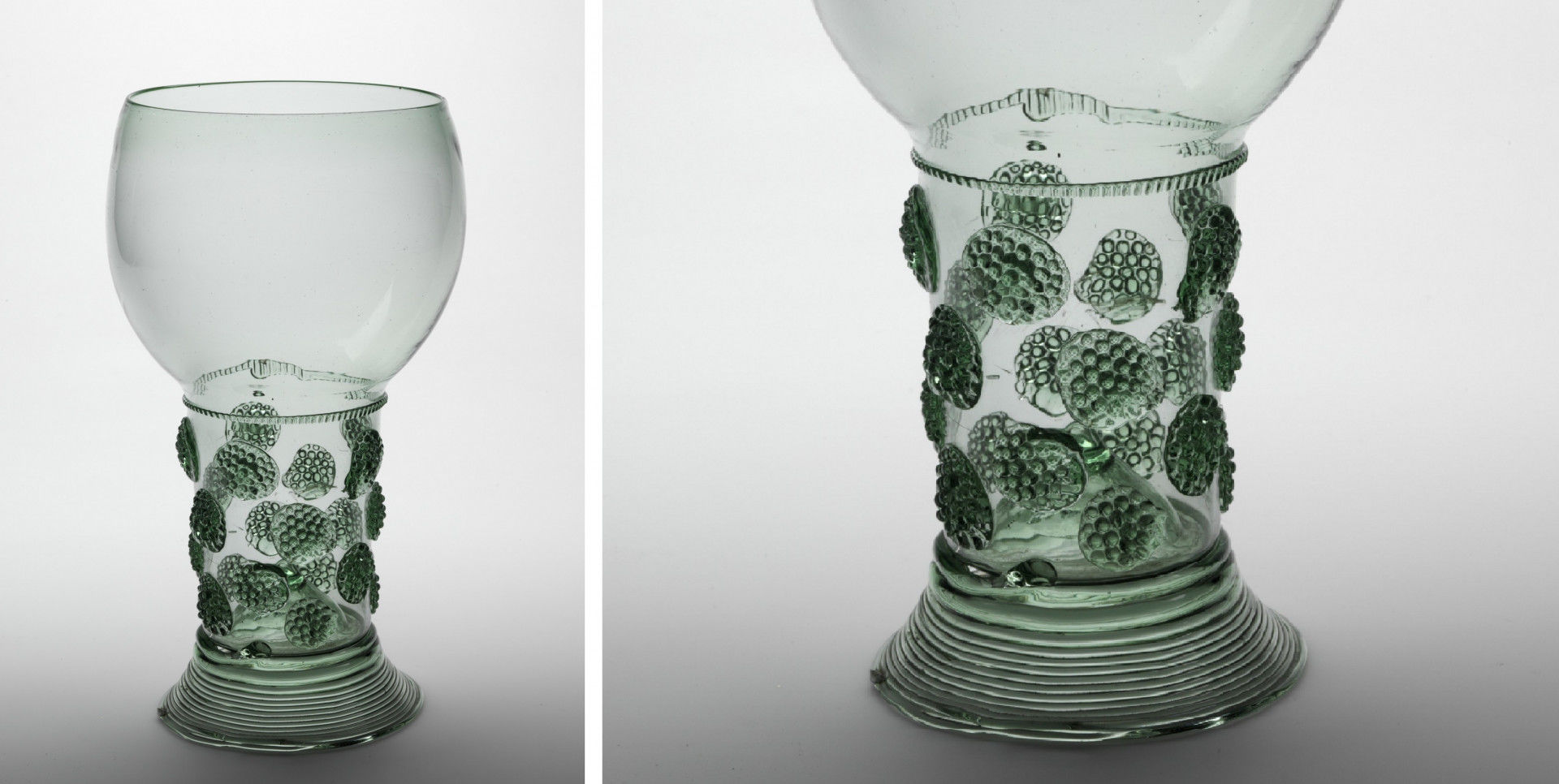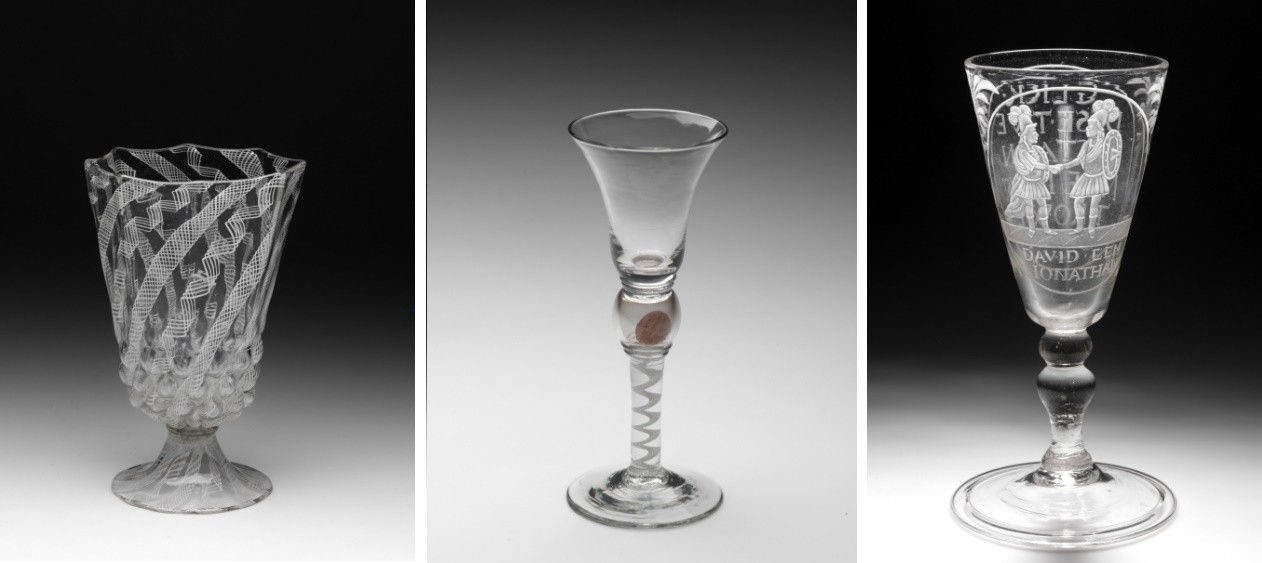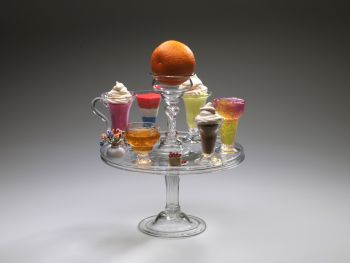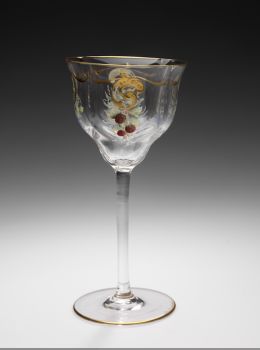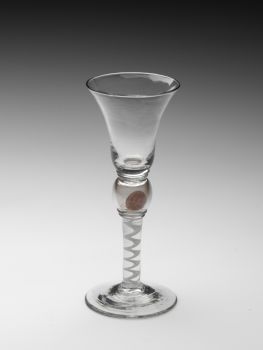Peter Korf de Gidts, From Collector to Dealer of antique glass
For about four decades, Peter Korf de Gidts is one of the leading Dutch dealers in antique glass. On a very cold winter day, I was very cordially and charmingly welcomed by Peter and his wife Wilma. Since my childhood, I’ve been familiar with antique and art dealers in the Netherlands and abroad, but rarely did I ever meet people with such enthusiasm, radiating with passion for their collection...
Introduction
Initially, in the 1960’s, Peter Korf de Gidts started as a collector of antique glass - a collection ignited by his purchase of a beautiful Venetian ‘cuppa’.
As avid collectors use to do, he read everything he could find on the history, the manufacturing and the decoration of glass and submerged himself in various museums and art fairs. Dozens of antique glasses, as well as some ceramics, were displayed in show cases. The colossal amount of books on glass, bulging out of the book cases, is only an indication of Peter Korf de Gidts’s knowledge on this subject.
His collection consists of glasses from all around Europe - not only the typical green-coloured ‘roemers’ as you can see on many 17th century Dutch still life paintings, but various glasses from (amongst others) Italy, Bohemia and England as well. Personally, I’m in particular fond of Venetian glass, each one of them a work of art of utmost elegance and refinement. (For centuries, only the Venetians knew how to make glass colourless; only one of the reasons the highly esteemed glass-blowers were in a way kept prisoners, afraid as the Venetian glass industry was that their secret might be stolen)
A large 'Roemer' (Römer), second half 17th century, Germany. Height: 21 cm. Diam.: 10 cm.
How it started
Peter Korf de Gidts opened his first business in Middenbeemster (north of Amsterdam), but was soon established in the Spiegelkwartier, the acclaimed art and antique quarter of the Dutch capital.
For several years, he served as president of the Spiegelkwartier association, in which many galleries and antique dealers were united. He participated in various renowned art fairs, amongst others those in Delft – the very first and legendary one - Breda, Naarden, Bruges. Knokke (Belgium), the PAN in Amsterdam and the Ceramics Fair in the Londen Dorchester Hotel. As an eminent connoisseur, highly esteemed for his knowledge of antique glass, Peter Korf de Gidts was one of the experts on the vetting committee, (controlling the quality and authenticity of the glasses at the TEFAF in Maastricht for many years.
Nowadays, Peter Korf de Gidts conducts his business from his loft at the Brouwersgracht.
Caveat emptor
It is remarkable to see how many very fine glasses, despite their extremely fragile nature, have been preserved during the past centuries, despite all wars, catastrophes and last but not certainly not least human negligence and clumsiness. After all, most glasses were items used on a daily or at least regular basis and most of the time, alcoholic beverages were consumed with these glasses.
Online trading: caveat emptor - It was interesting to discuss the matter of online trading in art and antiques with Peter and Wilma Korf de Gidts. From the one hand, as they pointed out, the internet can be quite a dangerous (and tempting) place for collectors, in particular for people starting with their collection, who might lack sufficient practice or could be too eager to buy.
Online sales of antique glass
This is certainly the case with antique glass as practically all sorts of antiques of financial value, glass has been (and is still being) copied and counterfeited. When a glass is offered by a private seller (say on Marktplaats, eBay or Catawiki), it is hardly possible, certainly for a less trained eye, to see the glass in full detail. It is impossible for the potential buyer to take the glass in his hands - to feel it. (After all, the tactile quality of glass is enormous, we don’t only see with our eyes!) It takes time and experience to acquire a profound knowledge of antique glass. Even for an appraiser of an online auction house the assessment of an offered glass might be a considerable challenge, certainly when based on a picture.
The risk of buying an imitation or a damaged glass with restorations - or even a fake specimen - is therefore considerable. Hence: 'caveat emptor', as the Romans said: 'let the buyer beware.'
From Left to Right: A rare 'Façon de Venise' goblet; An English-Dutch coin goblet; A 'Friendship' goblet depicting King David and Jonathan.
Importance of a good reputation
When purchasing an object (whether it be a glass or something else) from a well-reputed dealer with a sound and trustworthy name, one can be sure that one is acquiring a genuine object of quality - at least in general. I remember an old Jewish saying: 'tov shem mi-shemen tov', meaning: 'a good name is better than good oil', an aphorism that concerns us all and most certainly the antique branch. In case of Peter Korf de Gidts, this saying applies to him without any doubt.
But the online business has its substantial advantages as well: thanks to the internet, it is much easier for collectors to discover objects of their desire, offered by dealers worldwide. The physical distance between collectors and dealers isn’t necessarily an obstacle anymore. Exploring the web, one might stumble upon a dealer abroad and decide to render him a visit or even to buy an object from the dealer online, which is of course perfectly possible when the dealer is well-reputed and reliable.
Table culture
Table culture - Peter and Wilma Korf de Gidts emphasized the importance of ‘table culture’ and the art of living with antiques. Many antique objects have been created with no other purpose than to be used by people - a chair to sit on, a candlestick to burn candles in, dinner service to eat from, silverware to eat with, glass to drink from and cabinets to store these objects. In most cases, these household effects are still perfectly useful and functional. Just because a 18th century glass or plate might be found in a museum, doesn’t mean you couldn’t use it anymore!
I have to admit I would be a bit anxious to actually drink my wine out of a stunning and delicate 16th century ‘tazza’ - it would be more safe in a display cabinet, to enjoy its beauty every day. However, the more firm 18th and 19th century wine or liquor glasses (or a good old 17th century ‘roemer’) could still be used without any worry and would look stunning on a dinner table.
Willem Claesz. Heda (1594-1680); Still-Life with Gilt Goblet, 1635, oil on panel, 88 x 113 cm. Rijksmuseum, Amsterdam.
Using antique glass
Personally, I often use early 19th century glasses in my household, which makes the pleasure of a good drink even more pleasant. (The whole experience of drinking from a glass from which people have been enjoying life for almost two hundred years is quite thrilling.)
The only ‘sacrifice’ you would have to make is to wash the glasses by hand (never ever put antique glasses in a dishwasher!), but any person with a passion for antiques would spend these few minutes in order to actually live with things of beauty, grace and delicacy. One should avoid rushing as much as possible, but certainly when it concerns having dinner with family or friends.
A revival of classic table culture - including the use of antique glassware and porcelain - would be to the benefit of (and a joy to!) everyone. And could you imagine anything more sustainable than antiques?
Where to go when buying antique glass?


